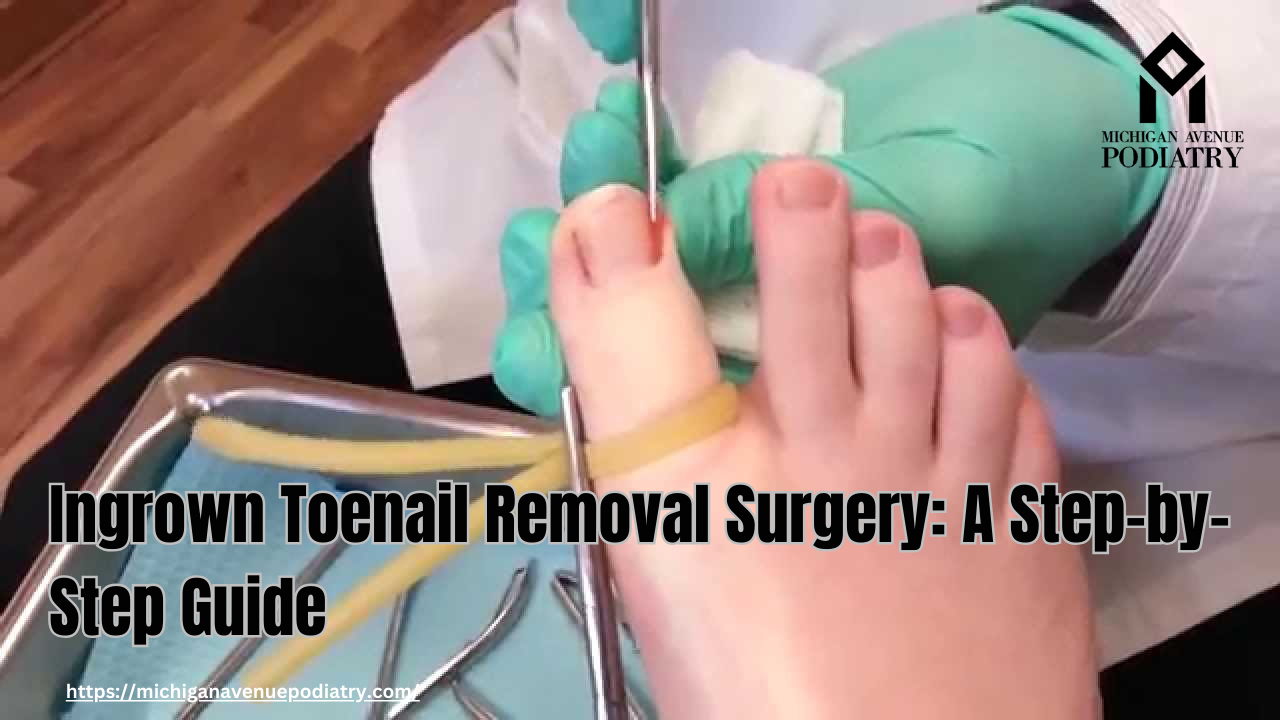Ingrown toenails, a common and often painful condition, occur when the corner or edge of a toenail digs into the surrounding skin. This can cause redness, swelling, throbbing pain after ingrown toenail surgery, and even infection. While home remedies like soaking and trimming can offer temporary relief, in some cases, ingrown toenail removal surgery becomes necessary.
If you’re facing this situation, understanding what to expect during the procedure can alleviate anxiety and prepare you for a smooth recovery. This blog post will guide you through everything you need to know about ingrown toenail removal surgery, from pre-surgery preparations to post-operative care.
Why is Ingrown Toenail Removal Surgery Needed?
While home care can sometimes manage mild ingrown toenails, surgery is often recommended for:
Recurring Ingrown Toenails: If home remedies fail to provide lasting relief, or you experience frequent ingrown toenails in the same toe, surgery offers a more permanent solution.
Severe Ingrown Toenails: In cases where the ingrown toenail is severely embedded in the skin, causing significant pain and inflammation, surgery is necessary to remove the ingrown portion and prevent further complications.
Infected Ingrown Toenails: If the ingrown toenail becomes infected, characterized by redness, pus, and throbbing pain after toenail removal, surgery is needed to remove the infected part of the nail and potentially prescribe antibiotics to clear the infection.
Preparing for Ingrown Toenail Removal Surgery:
- Consultation: During your initial consultation with a podiatrist (foot doctor), they will examine your toe, discuss your medical history, and assess the severity of the ingrown toenail. X-rays might be needed in specific cases.
- Pre-operative Instructions: Your podiatrist will provide detailed pre-operative instructions, which might include:
- Fasting: You might be advised to avoid eating or drinking anything (except water) for a few hours before the surgery, depending on the type of anesthesia used.
- Medications: Inform your podiatrist about any medications you’re currently taking, as they might need to be adjusted before surgery.
- Footwear: Wear comfortable shoes that can easily slip on and off after surgery.
- Transportation: Arrange for someone to drive you home after the surgery, as the anesthetic might affect your ability to operate a vehicle safely.
What to Expect During Ingrown Toenail Removal Surgery:
Ingrown toenail removal surgery is typically an outpatient procedure performed in a podiatrist’s office. Here’s a breakdown of what to expect:
- Anesthesia: Local anesthesia is the most common option, numbing the toe and surrounding area. In some cases, particularly for children or patients with anxiety, a light sedation might be used.
- Procedure: The podiatrist will clean and disinfect the area. A small incision might be made in the skin near the ingrown toenail edge. A portion of the ingrown nail will be removed using sterile instruments like clippers or lasers. In some cases, the podiatrist might also remove a small portion of the nail bed (matrix) to prevent future ingrown occurrences.
- Wound Care: The podiatrist will dress the wound with a bandage to control bleeding and promote healing. The entire procedure typically takes 15-30 minutes.
Recovery After Ingrown Toenail Removal Surgery:
Following surgery, you can expect some soreness and discomfort. Here are some tips to optimize your recovery:
- Pain Management: Over-the-counter pain relievers like ibuprofen or acetaminophen can help manage discomfort.
- Wound Care: Follow your podiatrist’s instructions for wound care, including changing bandages regularly and keeping the area clean and dry.
- Elevation: Elevate your foot above your heart as much as possible to reduce swelling.
- Rest: Avoid strenuous activity for a few days after surgery. Gradually resume normal activities as tolerated.
- Footwear: Wear loose-fitting shoes that accommodate any swelling and avoid putting pressure on the affected toe. Your podiatrist might advise the temporary use of special footwear during healing.
Potential Risks and Complications:
Ingrown toenail removal surgery is a safe and common procedure. However, like any surgery, there are potential risks:
- Infection: Proper wound care is crucial to minimize the risk of infection.
- Bleeding: Minor bleeding is normal after surgery. If you experience excessive bleeding, contact your podiatrist immediately.
- Recurrence: While the procedure aims to prevent future ingrown toenails, it’s still possible for them to recur in some cases.
- Nerve damage: There’s a small risk of damaging nerves near the toe during surgery, which can lead to numbness or tingling.
When to Call Your Podiatrist:
While some discomfort is expected after surgery, be sure to contact your podiatrist right away if you experience any of the following:
- Increased pain or swelling
- Redness, pus, or signs of infection around the wound
- Excessive bleeding
- Numbness or tingling that worsens or persists for several days
Preventing Ingrown Toenails:
The following tips can help prevent ingrown toenails from developing in the first place:
- Proper Toenail Trimming: Cut your toenails straight across, avoiding cutting them too short or rounding the corners.
- Wear Well-Fitting Shoes: Choose shoes that provide adequate space for your toes and avoid narrow or pointed shoes.
- Maintain Good Foot Hygiene: Wash your feet daily and dry them thoroughly, especially between the toes.
Conclusion:
Ingrown toenail removal surgery is a quick and effective procedure to address the discomfort and potential complications associated with ingrown toenails. Consulting with a podiatrist and following their pre- and post-operative instructions will optimize your experience and ensure a smooth recovery.


